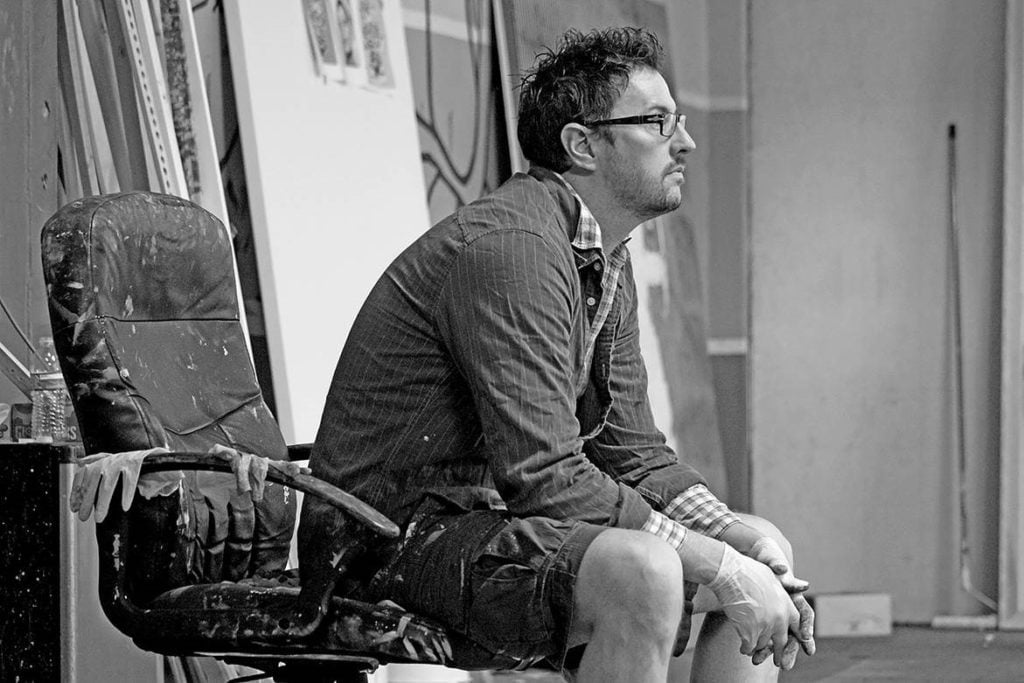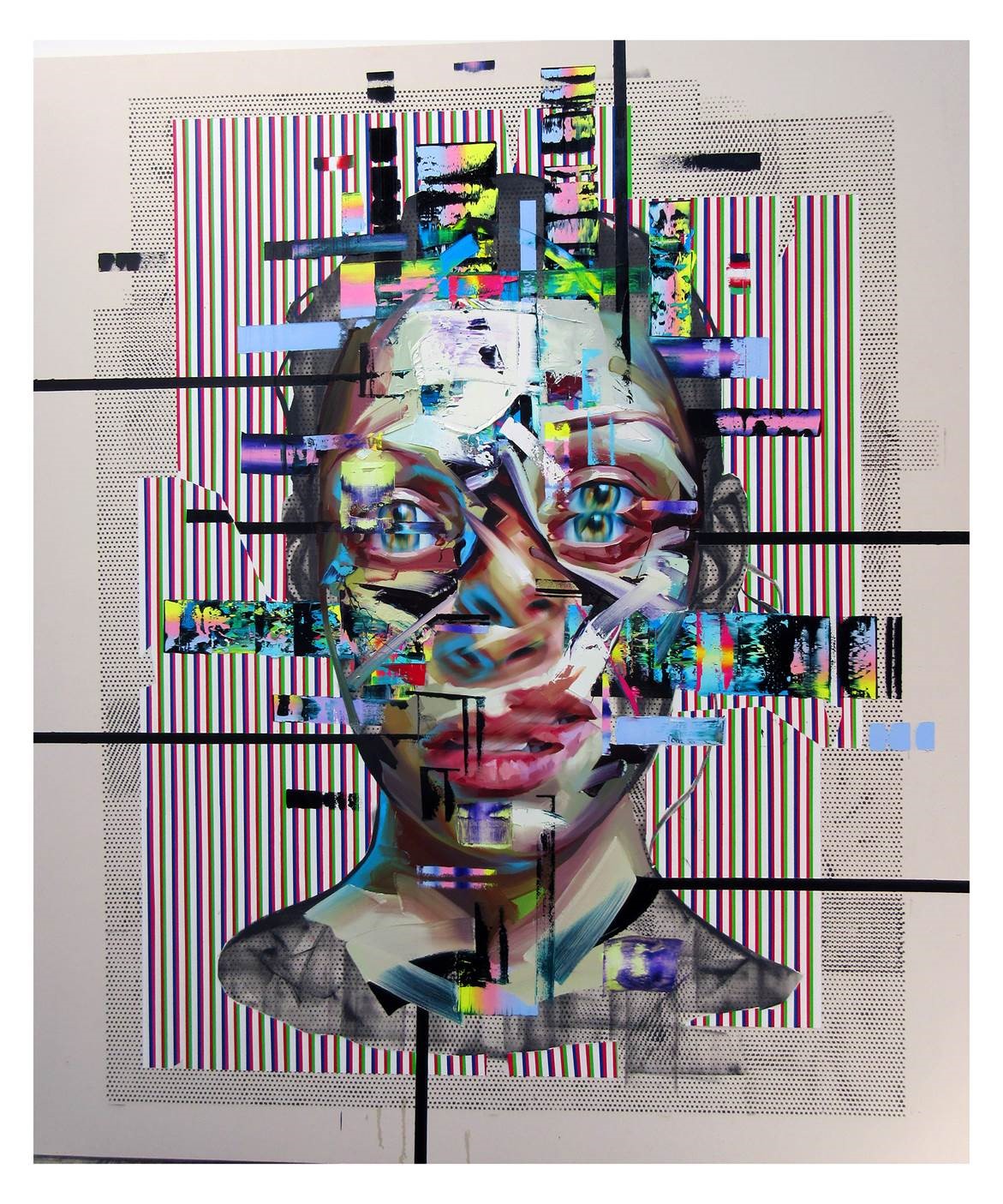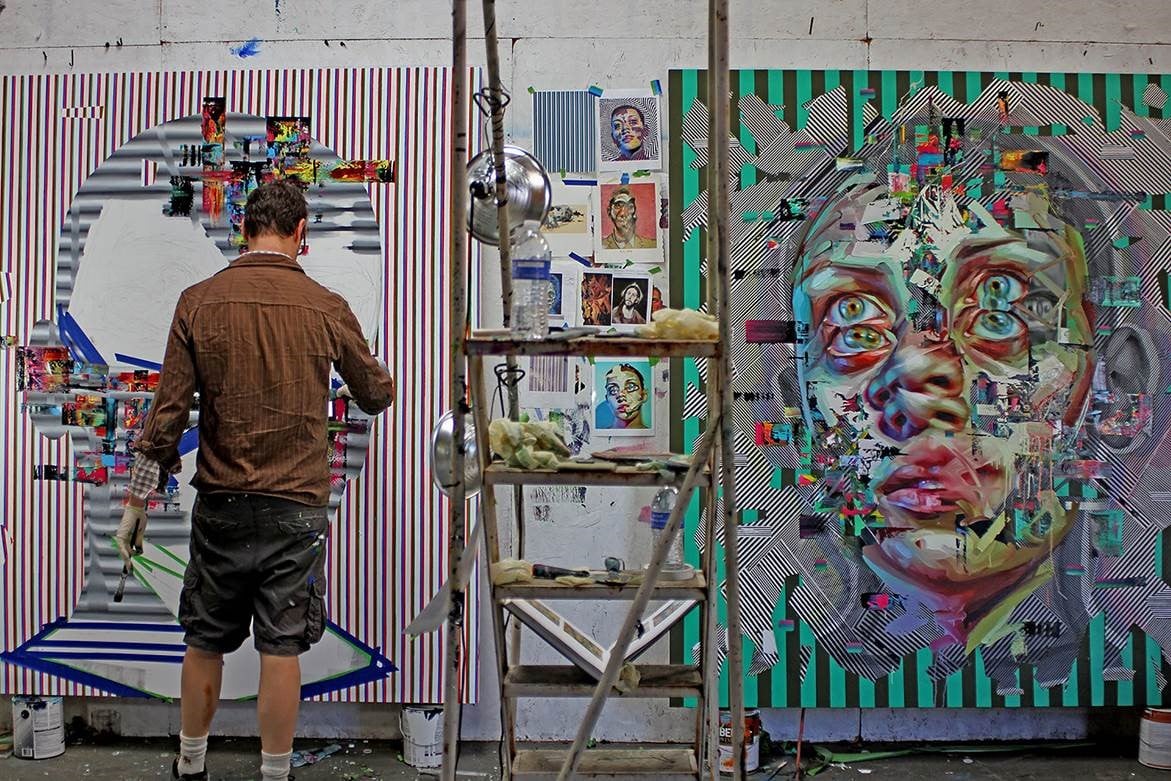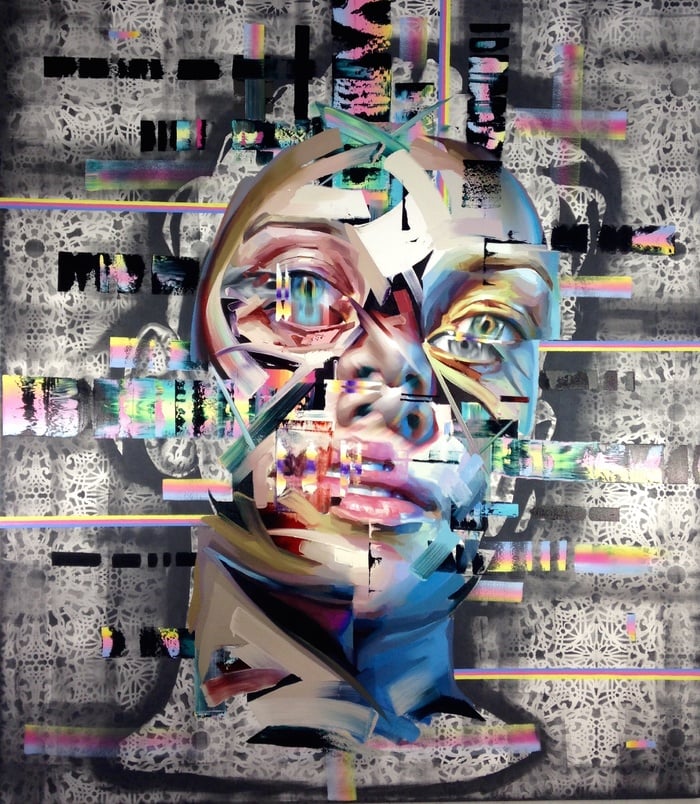Art & Exhibitions
artnet Asks: Artist Justin Bower Got Stabbed, Went to Grad School
One thing led to another.

One thing led to another.

Artnet News

The canvases of Justin Bower seem thick with technology, teaming with flashing metal and blooming pixels that burst out from under the skin of the anonymous portraits he paints. Describing his subjects as de-stabilized and fractured post-humans, Bower looks to the future, using his practice to question the nature of humanity in the face of so much expanding technology.
His latest exhibition “The Humiliations” is on view at UNIX Gallery through October 17. In this candid interview, the Los Angeles-based Bowen describes the violent way his career began—buckle up, it’s a long and entertaining story—and what types of humiliations we face as a species, and how he captures them in paint.
Describe the journey that led you to be an artist.
Well, my professional career started with a stabbing—my stabbing.
But before that took place, it started when I was in 3rd or 4th grade, when at the end of the year our yearbooks would arrive, and my classmates would pay me to draw in their books. I realized then the commerce part of art, that it was a coveted thing for some reason. I felt special, needed. It spread to designing skateboards and other paraphernalia, but it was in high school that the profundity of art showed itself to me. A confluence of athleticism, art history, and philosophy all appeared to me. I started drawing basketball players in mid-air—movement was very important to me then. I followed all athletics, art history, and philosophy into college, where I played football for the University of Arizona as a wide receiver, took studio classes, and studied philosophy. My studio classes were running into practice and making me late, so my coach came to me and gave me an absurd ultimatum: “It’s either football or your education.” That episode galvanized me with a new drive to make this art thing happen, and many more episodes were needed after that one.

Justin Bower, Ontological Hygiene (2015). Courtesy of UNIX Gallery.
I graduated and moved to Santa Ana, CA, into the very nascent beginnings of an art colony, and where most of the undocumented community found refuge. I stayed in a converted mechanic garage where, in the middle of my room, was an oil drain still ready for use. Insane scrawling in the vein of William S. Boroughs or a deranged E.E. Cummings mixed with bad a Cy Twombly covered my walls, put there by any passersby who dared come in. It was slowly revealing the order of my mind. It was there where I met with subterranean philosophers, addicts posing as artists, artists posing as addicts, the mentally ill, and a host of strange characters. I painted every day, drank every night, and read when my head was clear. I contacted tuberculosis after the 8th year there, and my career was non-existent.
It was a night after a bout of sport-drinking that I was asked to escort a woman home. As we passed from dark passages to lit ones, a group of five gang members—no older than 18 it seemed to me—surrounded me. I gave a heroically drunken growl and started swinging. It was clear they wanted nothing but to hurt me, for some initiation reasons. A woman screamed from a second story window above us, and as we all stared up, the knife sunk into the left side of my belly. It was then I realized I should go to graduate school.
Where do you find inspiration for your work?
I find that when you look at descriptions of the state of humanity, subjectivity, and post-human incantations, there is an awful lot of imagery there. Like liquid, leaking, fractured, holographic, destabilized, liminal, overlaps, interfaces, feedback loops etc.—they all inform my painting as I move along. I’m excited by patterns and repetition underneath a fleshy or painterly mark. I especially like to hook up “theories of subjectivity” rhetoric with pictures of wounds to the body and face as a starting point.

Justin Bower in the studio. Courtesy of UNIX Gallery.
Describe your creative process. Do you have any patterns, routines, or rituals when you’re in your studio?
It all depends on where I’m at in the painting process. I like to start a painting by reading a lot in the morning, looking at other contemporary painting and art history, and ease on into the painting by finding the tenor of the piece. At the mid-point of the painting, I like to get in and start as soon as possible, like a bull after a red cape. In the end point, I’ll sometimes have a couple drinks and get loose at the finish line.
Tell us about your current show, “The Humiliations.”
The idea of a free and autonomous consciousness is being questioned by neuroscience, and more overtly through the many apparatus of social control that new technology has allowed. The uniqueness of the human species is contested by biotechnology and genetics; the singularity of the human mind is undermined by informatics, robotics, and artificial intelligence. In attacking the humanist idea of human exceptionalism, these developments continue a series of ongoing “humiliations” of the Enlightenment-defined human. The fracturing of the human, doubling of sense organs, opening of the flesh, and the violence to the stability of the subject are all “humiliations” to the autonomous and free-willed human of the past. But this “humiliation” has always been inside the human from the beginning. Erupting from humanity and levied back down upon himself.
Tell us about someone who has been a major influence in your life.
My wife. I met her the same period as my stabbing, a very dark period. Without any prior knowledge of art or the art world, she supported me with a faith worthy of a gospel. I wouldn’t be here without her optimism, intelligence, and attention to detail she has brought to my career, not to mention bringing my son Mack into being.
What are you currently working on?
I’m working on putting these subjects I have painted into a fuller context. Figures in holographic, pattered environments with doppelgangers, fractured humans with chairs, claustrophobic rooms, etc. Disrupting the usual Western point-perspective and moving these figures into a virtual world. A series of these will be made soon.

Justin Bower, Tabula Rosa (2015). Courtesy of UNIX Gallery.
What has been the highlight of your career so far?
It must be my first solo show in New York, on the famous 24th Street with UNIX Gallery in 2013. But I’m also excited about my first solo museum show at Museum of Art and History, in Lancaster, CA this December 5. It’s a mini five-year retrospective of my work, from my troubled time with Ace Gallery to my glorious time with Unix Gallery.
What is your favorite movement in art?
I’m fascinated by the period from the 1940s to the 1980s. It was a whiplash ride of diametrically opposed ways of seeing painting, with each movement dying from the direct opposition of discourse by the generation of next. You see Picasso’s grandiosity, DeKoonings’ rise, then Pop and Conceptualism smashing all painting. Then the strange resurrection of Neo-Expressionism, finally.
If you could have dinner with any three artists, living or dead, who would you choose?
Francis Bacon: His conversations with Sylvester notwithstanding, I would love to hear more of his eloquence and the tortured logic he uses to describe his leaking, distorted bodies, and how his work holds up in today’s post-human future.
Bill Watterson: His philosophical adroitness in comics and his J.D. Salinger-like aloofness makes him very appealing, but his hold over me as a child and that fertile imagination was enormous.
Kurt Cobain: He’s my generations Lord Byron, sensitive but terminally ironic, Burroughs-style cut-up lyrics, with his constant contradictions of himself that scream.
If you weren’t an artist, what do you think you’d be doing?
Picking fleas out of my hair, looking for a nice shady spot to sleep.